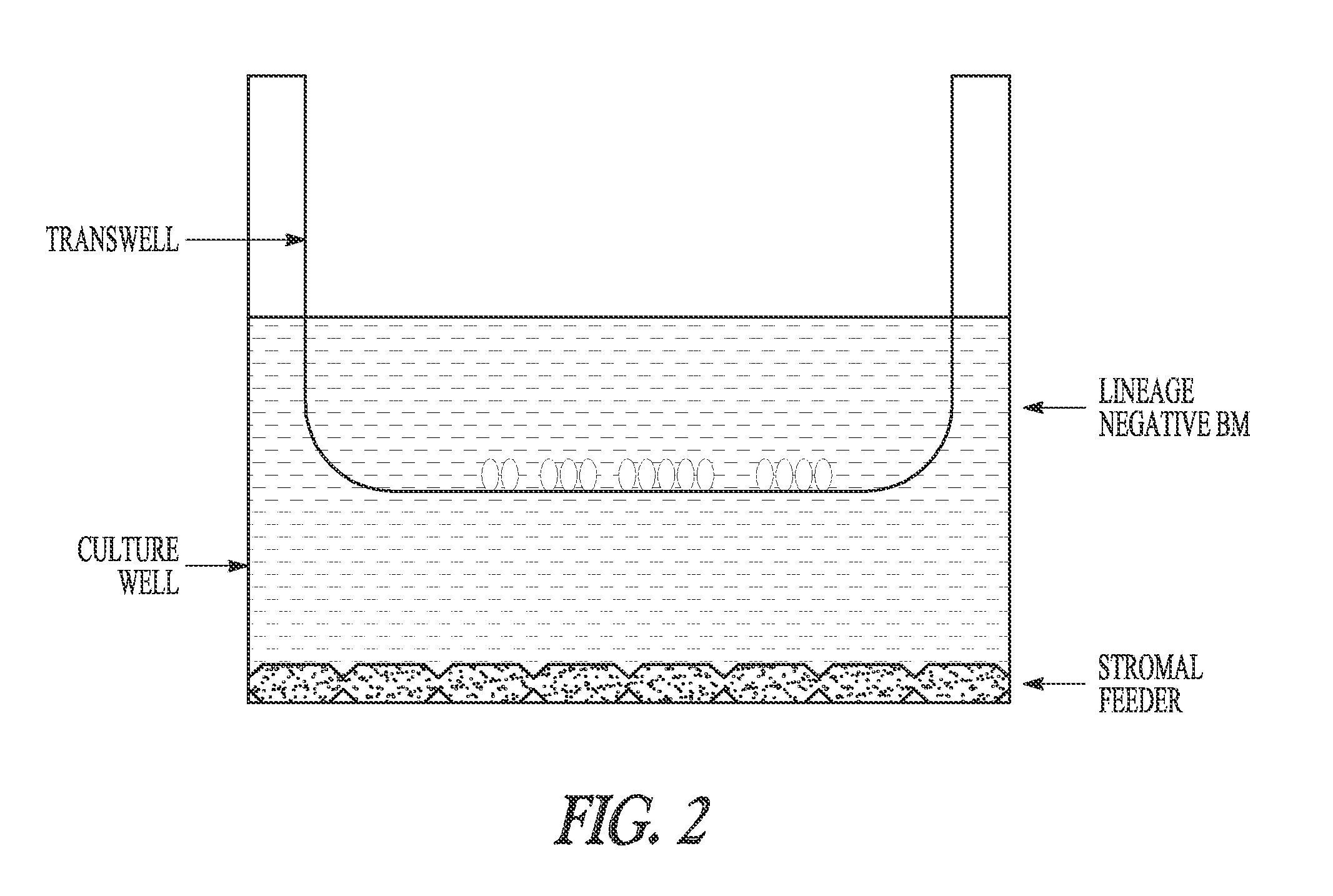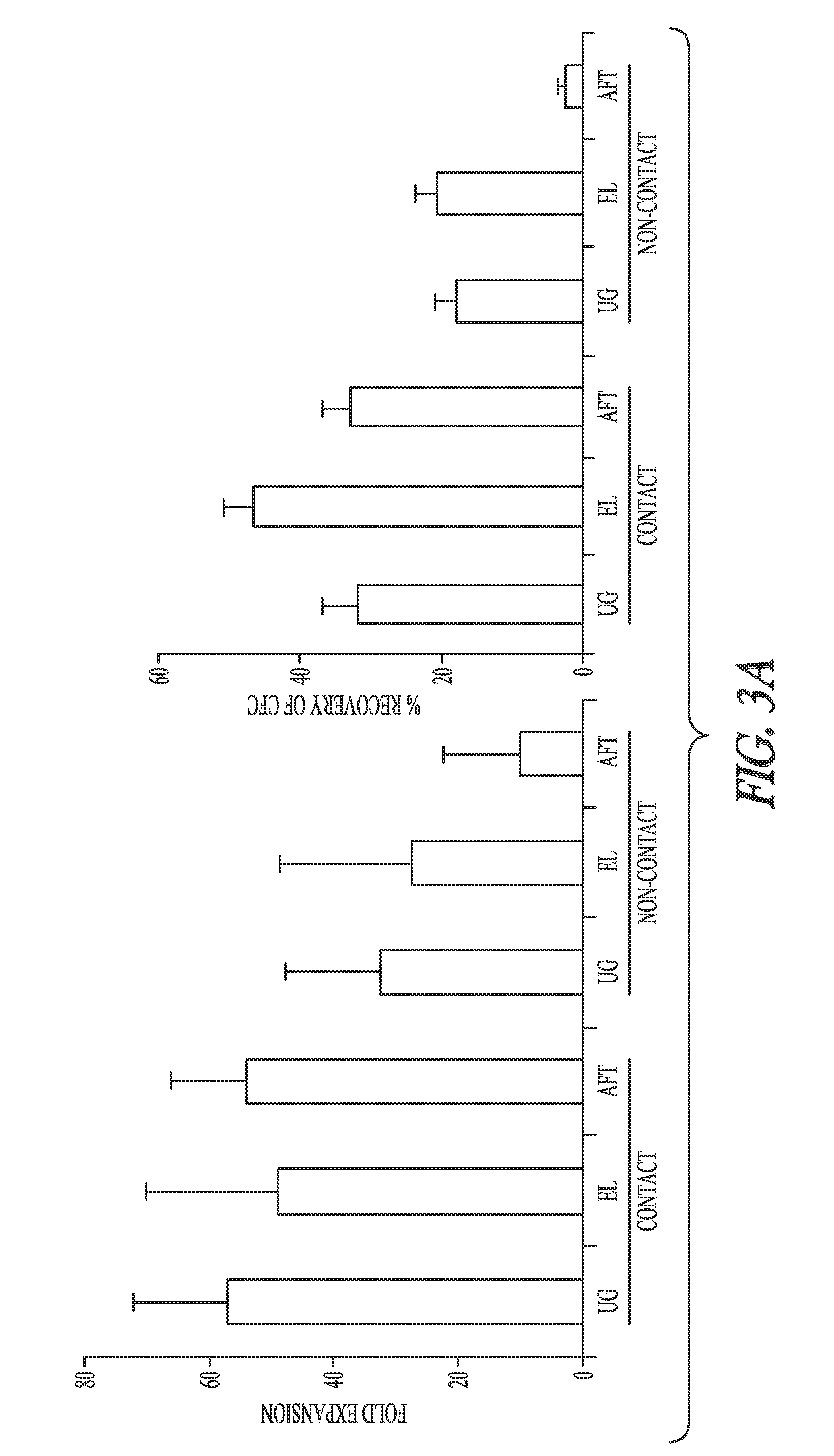MAINTENANCE/EXPANSION OF HSC's
a technology of hsc and maintenance, applied in the field of culturing somatic stem cells, can solve problems such as the renewal of hsc division
- Summary
- Abstract
- Description
- Claims
- Application Information
AI Technical Summary
Benefits of technology
Problems solved by technology
Method used
Image
Examples
example 1
AGM Derived Stromal Cell Line Secretes Factor(s) Capable of Supporting Hematopoietic Stem Cells
Introduction
[0146]Hematopoietic stem cells (HSC) are responsible for maintaining hematopoiesis throughout adult life. HSC fate decisions are regulated by both extrinsic and intrinsic signals. In vivo, extrinsic signals are emanated by the microenvironment where the cell resides. These signals are both direct cell-cell interaction based, wherein receptors on HSC bind to ligands on cells within their microenvironment (including among others osteoblasts, endothelial cells, and marrow stroma cells), cell-extracellular matrix (ECM) based (fibronectin, proteoglycans, among others), as well as, due to soluble factors secreted by cells residing in the microenvironment or present at a more distant location (e.g. erythropoietin secreted chiefly by cells in the kidney). The microenvironment wherein HSC reside differs throughout ontogeny, perhaps because distinct signals are needed for the proper deve...
example 2
Gene Expression Profiling of HSC Supportive Stromal Cell Lines
Introduction
[0167]The HSC niche consists of “stromal” cells (including osteoblasts, endothelial cells, myofibroblasts, and macrophages) and extracellular matrix (ECM) with which HSC can interact, as well as secreted factors that affect HSC, all of which regulate cell fate decisions. Although many cytokines and growth factors have been isolated that affect HSC, none have been identified that can support HSC maintenance long-term (more than 1 week) in vitro. Stromal cell lines have been isolated from different HSC supportive environments during embryonic development and have been used to mimic the microenvironment of the HSC. We (and others) have found that some of these feeders support HSC maintenance, albeit no real expansion has been achieved in vitro. Initially it was believed that stromal cell lines could only support primitive hematopoietic cells that were plated in contact with the stromal cells, as hematopoietic cel...
example 3
Wnt5a is Capable of Maintaining Hematopoietic Stem Cells
Introduction
[0189]Many studies have found that cytokines and / or growth factors alone fail to support the maintenance of CR-LTR-HSC in vitro. More recently, studies have evaluated the role of morphogens known to play a role in early embryo development in HSC self-renewal, maintenance and differentiation. These include members of the hedgehog (HH) family, the transforming growth factor (TGF) family, and Wnts.
[0190]In the previous two examples it was demonstrated that the UG26-1B6 cell line derived from the urogenital ridge of E10.5 mouse embryos possesses the unique ability to maintain CR-LTR-HSC for 3 weeks cultured in transwells above the feeder without addition of exogenous cytokines. Subsequent studies wherein we compared the transcriptome of UG26-1B6, and EL08-1D2 cells using Affymetrix gene arrays identified Wnt5a as one of the genes coding for a secreted factor significantly higher expressed in UG26-1B6 cells.
[0191]Wnt pro...
PUM
| Property | Measurement | Unit |
|---|---|---|
| Fraction | aaaaa | aaaaa |
| Fraction | aaaaa | aaaaa |
| Fraction | aaaaa | aaaaa |
Abstract
Description
Claims
Application Information
 Login to View More
Login to View More - R&D
- Intellectual Property
- Life Sciences
- Materials
- Tech Scout
- Unparalleled Data Quality
- Higher Quality Content
- 60% Fewer Hallucinations
Browse by: Latest US Patents, China's latest patents, Technical Efficacy Thesaurus, Application Domain, Technology Topic, Popular Technical Reports.
© 2025 PatSnap. All rights reserved.Legal|Privacy policy|Modern Slavery Act Transparency Statement|Sitemap|About US| Contact US: help@patsnap.com



